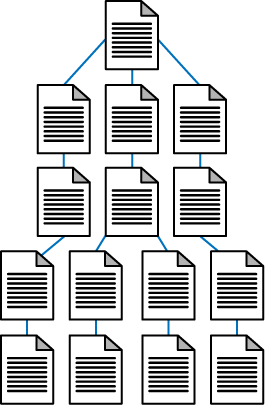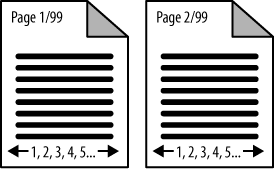3. Flat Versus Deep Architecture
One very strict rule for search friendliness is the creation of
flat site architecture. Flat sites require a minimal number of clicks to
access any given page, whereas deep sites create long paths of links
required to access detailed content. For nearly every site with fewer
than 10,000 pages, all content should be accessible through a maximum of
three clicks from the home page and/or sitemap page. At 100 links per
page, even sites with millions of pages can have every page accessible
in five to six clicks if proper link and navigation structures are
employed. If a site is not built to be flat, it can take too many clicks
to reach the desired content, as shown in Figure 7. In contrast, a flat site (see Figure 8) allows users and search engines to
reach most content in just a few clicks.


Flat sites aren’t just easier for search engines to crawl; they
are also simpler for users, as they limit the number of page visits the
user requires to reach his destination. This reduces the abandonment
rate and encourages repeat visits.
When creating flat sites, be aware that the engines are known to
limit the number of links they crawl from a given page. Representatives
from several of the major engines have said that more than 100
individual links from a single page might not be followed unless that
page is of particular importance (i.e., many external sites link to
it).
Following this guideline means limiting links on category pages to
100 or fewer, meaning that with the three-clicks-to-any-page rule,
10,000 pages is the maximum number possible (unless the home page is
also used as a Sitemap-style link guide, which can increase the max,
technically, to 1 million).
The 100-links-per-page issue relates directly to another rule for
site architects: avoid pagination wherever possible.
Pagination, the practice of creating a list of
elements on pages separated solely by numbers (e.g., some e-commerce
sites use pagination for product catalogs that have more products than
they wish to show on a single page), is problematic for many reasons.
First, pagination provides virtually no topical relevance. Second,
content that moves into different pagination can create duplicate
content issues. Last, pagination can create spider traps and hundreds or
thousands of extraneous, low-quality pages that can be detrimental to
search visibility. Figure 9 shows how
pagination structures do not benefit search engines.

So, make sure you implement flat structures and stay within
sensible guidelines for the number of links per page, while retaining a
contextually rich link structure. This is not always as easy as it
sounds. Accomplishing this may require quite a bit of thought and
planning to build a contextually rich structure on some sites. Consider
a site with 10,000 different men’s running shoes. Defining an optimal
structure for that site could be a very large effort, but that effort
will pay serious dividends in return.